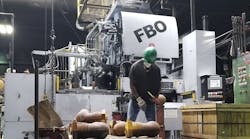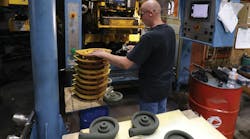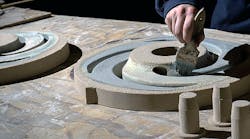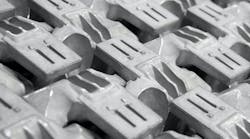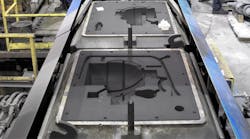Four European foundries have been part of a research team that recently completed a project to prove the effectiveness of producing castings in molds formed of magnetic material — specifically, steel shot — rather than sand or polystyrene. The "Magnet" research project was coordinated by Fundacion Inasmet, a Spanish research center, and included four different types of foundries: ferrous (Fundiciones del Estanda) and nonferrous (W.H. Rowe & Son Ltd.) sand casting, lost foam casting (GussStahl Lienen GmbH), and investment casting (Krolmet). Also included was a company that develops magnetic instruments, a foam pattern supplier, and an OEM buyer of castings.
In order to advance the magnetic molding concept toward industrial use, the research was divided into segments that were assigned to different partners. Five cast parts currently produced by other molding processes were selected for the development. A pilot magnetic molding plant was set up, and process equipment was identified — magnetic devices, vibration and casting units, and ancillary equipment for optimization of the process and production of samples. The design of the magnetic field was determined according to different geometrical and magnetic considerations.
Next, process optimization was conducted at Inasmet using an electromagnet, vibrating table, induction furnace, and casting box as the pilot-scale equipment. The effect of the magnetic field on the castings' microstructure was studied, and sample properties produced with ferrous and nonferrous alloys were measured and compared to the properties of samples obtained with the standard casting processes. Different aspects of the new process were optimized, specifically the compaction of steel shot and the casting parameters. Samples were produced for preliminary metallurgical and mechanical characterization.
Demonstrator Parts Analyzed
Each of the five demonstrator parts cast in the project were analyzed with Magmasoft software to understand the solidification behavior of the different metals to be cast, and to suggest the best filling and feeding systems design. All five of the test castings were produced successfully at the participating foundries, according to their standard methods and using the magnetic molding process. The finished castings were tested and evaluated, with each participant taking a different assignment.
All the project results were positive, according to the published results, and the advantages of the magnetic molding were confirmed. Two results were called "especially relevant": the magnetic field applied during the casting and solidification established greater mold cohesion; and additional rigidity provided to the steel shot mold by the magnetic field provided greater flexibility in the selection and placement of feeding and filling systems, orientation of the casting, and thickness of the components.
Also, the results indicated that all the castings produced with magnetic molding showed microstructures with smaller grain sizes than those from the corresponding traditional foundry processes. The ability of the steel shot to dissipate heat showed a direct link to the size of the grains and the increase in ductility and yield stress.
The results confirmed that magnetic molding is an economically and technically valid alternative lost foam casting for producing complex shapes, with improved performance. The researchers indicated success with numerous alloys, including aluminum, bronze, gray iron, and steel.
The finished parts showed improved mechanical properties, and production cycle times were reduced – which may enhance the competitiveness and expand the range of products for foundries using the process.
Among the technical results concluded by the researchers was that applying magnetic molding would improve the mechanical properties of both ferrous and nonferrous castings produced by the lost foam casting, mainly because of the fine microstructures that result from the reduced grain size of the alloys.
Another conclusion is that the magnetic fields chosen for the pilot project apparently do not influence the microstructure of the materials. Intensities up to 6-7 Teslas were tested with no relevant effect on the microstructure.
The magnetic fields proved to be a positive influence on the dimensional tolerances of gray iron castings. They make it possible to apply different metal flow orientations, and increase lost-foam process flexibility in terms of feeding and filling design.
The magnetic molding process is an environmentally friendly approach, because steel shot can be reused and/or recycled, and the magnetic field has no apparent effect on the health of workers.
A shorter cycle time compared to traditional lost foam processes may make the foundries using magnetic molding more competitive, researchers predicted. Investments needed to implement the technology are low, and no significant change is required to the facilities or equipment already in use by lost foam foundries.


